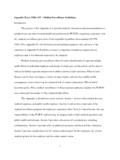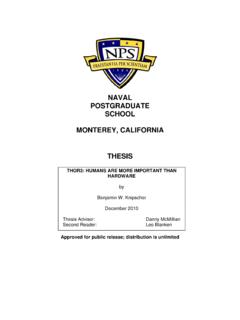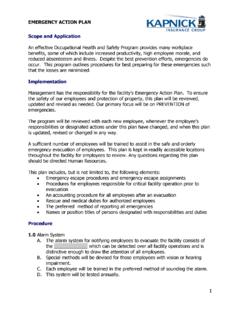Transcription of RichaRd c. detmeR - Jones & Bartlett Learning
1 RichaRd c. de tmeRMiddle Tennessee State UniversityThird EdiTion80x86 Assembly Language and Computer ArchitectureIntroduCtIon 11/24/2014 5:07:00 PM Jones & Bartlett Learning , LLC. NOT FOR SALE OR DISTRIBUTIONW orld HeadquartersJones & Bartlett Learning5 Wall StreetBurlington, MA & Bartlett Learning books and products are available through most bookstores and online booksellers. To contact Jones & Bartlett Learning directly, call 800-832-0034, fax 978-443-8000, or visit our website, 2015 by Jones & Bartlett Learning , LLC, an Ascend Learning CompanyAll rights reserved. No part of the material protected by this copyright may be reproduced or utilized in any form, electronic or mechanical, including photocopying, recording, or by any information storage and retrieval system, without written permission from the copyright content, statements, views, and opinions herein are the sole expression of the respective authors and not that of Jones & Bartlett Learning , LLC.
2 Reference herein to any specific commercial product, process, or service by trade name, trademark, manufacturer, or otherwise does not constitute or imply its endorsement or recommendation by Jones & Bartlett Learning , LLC and such reference shall not be used for advertising or product endorsement purposes. All trademarks displayed are the trademarks of the parties noted herein. Introduction to 80x86 Assembly Language and Computer Architecture, Third Edition, is an independent publication and has not been authorized, sponsored, or otherwise approved by the owners of the trademarks or service marks referenced in this may be images in this book that feature models; these models do not necessarily endorse, represent, or participate in the activities represented in the images. Any screenshots in this product are for educational and instructive purposes only. Any individuals and scenarios featured in the case studies throughout this product may be real or fictitious, but are used for instructional purposes CreditsChief Executive Officer: Ty FieldPresident: James HomerChief Product Officer: Eduardo MouraExecutive Publisher: William BrottmillerPublisher: Cathy L.
3 EspertiAcquisitions Editor: Laura PagluicaEditorial Assistant: Brooke YeeAssociate Marketing Manager: Cassandra PetersonDirector of Production: Amy RoseComposition: Laserwords Private Limited, Chennai, IndiaCover Design: Kristin E. Parker Director of Photo Research and Permissions: Amy WrynnCover Image: Lines: echo3005/ShutterStock, Inc.; binary code: echo3005/ShutterStock, and Binding: Edwards Brothers MalloyCover Printing: Edwards Brothers Malloy Library of Congress Cataloging-in-Publication DataDetmer, RichaRd C. Introduction to 80X86 assembly language and computer architecture / RichaRd C. detmeR . Third edition. pages cm Includes index. ISBN 978-1-284-03612-1 (pbk.) ISBN 1-284-03612-X (pbk.) 1. Computer architecture. 2. Assembly languages (Electronic computers) 3. Intel 80x86 series microprocessors. I. Title. 2015 2 dc23 20130340846048 Printed in the United States of America18 17 16 15 14 10 9 8 7 6 5 4 3 2 1 Substantial discounts on bulk quantities of Jones & Bartlett Learning publications are available to corporations, professional associations, and other qualified organizations.
4 For details and specific discount information, contact the special sales department at Jones & Bartlett Learning via the above contact information or send an email to 21/24/2014 5:07:00 PM Jones & Bartlett Learning , LLC. NOT FOR SALE OR DISTRIBUTIONFor my mother, Emma Langenhop detmeR Baldwin Toombs, and my uncle, Carl E. Langenhop, both of whom encouraged me to become a 31/24/2014 5:07:00 PM Jones & Bartlett Learning , LLC. NOT FOR SALE OR 41/24/2014 5:07:00 PM Jones & Bartlett Learning , LLC. NOT FOR SALE OR DISTRIBUTIONC ontentsPreface ixChapter 1 Representing Data in a Computer 1 Binary and Hexadecimal Numbers 2 Character Codes 8 Unsigned and Signed Integers 10 Integer Addition and Subtraction 15 Other Systems for Representing Numbers 20 Chapter Summary 23 Chapter 2 Parts of a Computer System 25 PC Hardware: Memory 26 PC Hardware: The CPU 28 PC Hardware: Input/Output Devices 34 PC Software 35 Chapter Summary 37 Chapter 3 Elements of Assembly Language 39 Assembly Language Statements 40 A Complete 32-Bit Example Using the Debugger 43 Data Declarations 50 Instruction Operands 55 A Complete 32-Bit Example Using Windows Input/Output 59 Input/Output and Data Conversion Using Macros Defined in 67 64-Bit Examples 71 Chapter Summary 51/24/2014 5:07:00 PM Jones & Bartlett Learning , LLC.
5 NOT FOR SALE OR DISTRIBUTIONC hapter 4 Basic Instructions 77 Copying Data 78 Integer Addition and Subtraction Instructions 92 Multiplication Instructions 103 Division Instructions 114 Chapter Summary 123 Chapter 5 Branching and Looping 125 Unconditional Jumps 126 Conditional Jumps, Compare Instructions, and if Structures 130 Implementing Loop Structures 141 for Loops in Assembly Language 149 Arrays 154 Chapter Summary 164 Chapter 6 Procedures 167 The 80x86 Stack 168 32-Bit Procedures with Value Parameters 175 Additional 32-Bit Procedure Options 183 64-Bit Procedures 197 Macro Definition and Expansion 204 Chapter Summary 210 Chapter 7 Bit Manipulation 213 Logical Operations 214 Shift and Rotate Instructions 223 Converting an ASCII String to a 2 s Complement Integer 234 Chapter Summary 237 Chapter 8 String Operations 239 Using String Instructions 240 Repeat Prefixes and More String Instructions 246 Character Translation 257 Converting a 2 s Complement Integer to an ASCII String 261 Chapter Summary 265vi 61/24/2014 5:07:01 PM Jones & Bartlett Learning , LLC.
6 NOT FOR SALE OR DISTRIBUTIONC hapter 9 Floating Point Operations 267 Floating Point Formats 268 80x86 Floating Point Architecture 271 Converting Floating Point to and from ASCII 291 Single-Instruction Multiple-Data Instructions 306 Floating Point Assembly Language Procedures with C/C++ 310 Chapter Summary 317 Appendix A Hexadecimal/ASCII Conversion 319 Appendix B Assembler Reserved Words 321 Appendix C Answers to Selected Exercises 329 Index 343 Contents 71/24/2014 5:07:01 PM Jones & Bartlett Learning , LLC. NOT FOR SALE OR 81/24/2014 5:07:01 PM Jones & Bartlett Learning , LLC. NOT FOR SALE OR DISTRIBUTIONThe first edition of Introduction to 80x86 Assembly Language and Computer Architec ture emphasized computer architecture over assembly language. In the years since it was published, assembly language use has declined but the need for a computer scientist to understand how the computer works on the inside has not.
7 The Second Edition emphasized basic 80x86 architecture even more than the first. I remain convinced that Learning a real instruction set and writing assembly language programs for a real com-puter are excellent ways to become acquainted with the basics of computer architecture. This emphasis on computer architecture continues with the Third to the Third EditionThe text has been updated to be used with Visual Studio 2012, although it remains com-patible with earlier versions of Visual Studio. All programs presented in this book have been tested using Visual Studio 2012, Professional Edition. There are over 100 new exercises and programming exercises. The design has been improved, with clearer layout and easier-to-read illustrations. There has been a major effort to eliminate errors. Ancil-lary materials include PowerPoint lecture outlines, sample examinations, and answers to all exercises for instructors.
8 Additionally, all program examples in this text are pro-vided for students and instructors on the book s website at / catalog/9781284036121/. The book remains suitable as a standalone text in an assem-bly language course or as a supplement in a computer architecture courseFeatures of the Second EditionThere were several major changes in the Second Edition, also incorporated in the Third Edition. For many people the most significant was the use of the Microsoft Visual Studio environment instead of stand-alone software. Visual Studio is widely used in academic and professional settings, and provides a robust environment for editing, assembling, debugging, and executing programs. Microsoft DreamSpark ( .com/) (formerly the Microsoft Academic Alliance) makes Visual Studio and other devel-opment software available to academic institutions at very low 91/24/2014 5:07:01 PM Jones & Bartlett Learning , LLC.
9 NOT FOR SALE OR DISTRIBUTIONThe 80x86 microprocessor family has expanded considerably in the past few years. This book continues to emphasize basic architecture; that is, features that are found on most CPUs, not just the 80x86 line. Since 64-bit processors now commonly power new PCs and 64-bit operating systems are now popular, this book includes 64-bit architec-ture. Much of the time 64-bit instructions are just more of the same, but there are a few major differences. This book s topics are arranged so that 64-bit operations can be covered or omitted at the instructor s discretion. It is impossible in a textbook to pro-vide full coverage of all 80x86 instructions. Intel provides comprehensive documenta-tion on their website ( ).The Second Edition had decreased emphasis on input/output, with corresponding increased emphasis on using the debugger to see what is going on inside the computer.
10 Macros for I/O, macros for converting from an ASCII string to a 2 s complement integer, and macros for converting from a 2 s complement integer to an ASCII string were included. The macros for I/O used dialog boxes and message boxes instead of console 6, Procedures, was changed to focus on the cdecl protocol. Using a stand-ard protocol makes it possible to cover calling assembly language procedures from a high-level language or an HLL procedure from assembly language. The very different 64-bit procedure protocol was also 9, Floating Point Operations, had major updates. Since all current 80x86 CPUs have floating point units, it no longer discussed how to code floating point opera-tions using processors without an FPU. It covered some SSE instructions because these are normally used instead of the FPU for FP operations in 64-bit mode.















